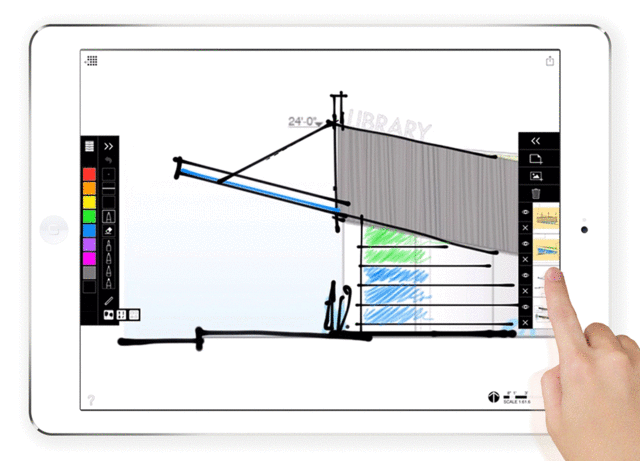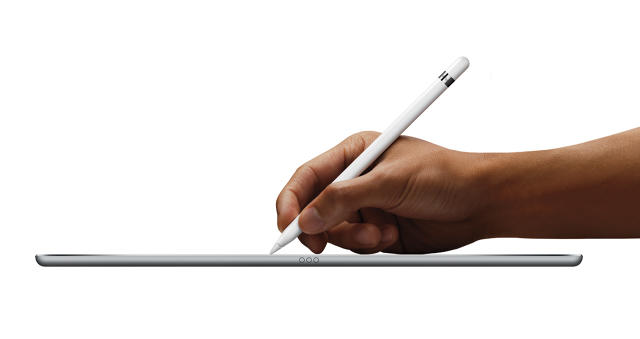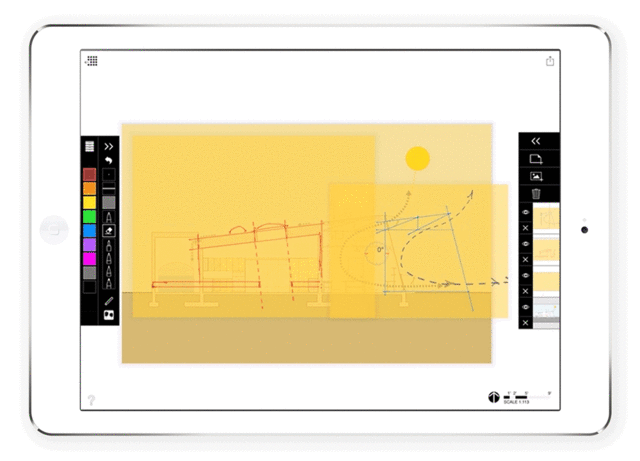SOFTWARE FOR CREATIVES MUST CULTIVATE SPACE FOR MUSING, WRITES MORPHOLIO CO-CREATOR ANNA KENOFF.
A tech VC recently asked me, “Do you even use your iPad anymore? I think they are over.” To which, I replied—perhaps a bit too loudly—”Yes!” There is nothing over when it comes to the potential of touch. Apple’s investment in the iPad Pro and Pencil only reinforces this.
Designers need tools that disinhibit the brain to allow room for creativity to happen. In this sense, the touch screen is one of the device revolution’s most important gifts to creatives. Touch can make the sought-after “ah ha” come easier.
While still a new frontier, neuroscientists such as Rex Jung, assistant professor of neurosurgery at the University of New Mexico, have looked closely into brain structure and function to better understand creativity—as opposed to intelligence. If you think of the brain as a series of pathways—where intelligence is like the speed and accuracy with which one makes connections along the paths—creativity occurs when the brain makes unexpected or new intersections.

To achieve this productive “meandering,” Jung and his colleagues hypothesize that you may need to enter a state of “transient hypo-frontality,” or a “down regulation of the frontal lobe” in order to allow other parts of the brain to take over, and encourage you to wander along new paths. They believe that the rule-based frontal lobe has to be slowed down in order for new forms of reasoning to occur—ultimately, spawning creative discovery.
Jung conducted a test in which he used sMRI, Structural Magnetic Resonance Imaging, to monitor the brain activity of undergraduate students while they were asked to perform tasks that required varying levels of creativity—convergent thinking, divergent thinking, insight, and reasoning measures. The images look at the thickness of the cerebral cortex, the undulating outer layer of the brain, and found that throughout the 131 cases, thinness of gray matter across various regions of the brain was positively correlated with creative capacity. In other words, thinner cortex equaled higher creativity.

Apple
In a parallel study, they looked at the white matter in the brain, or the networks of cells that crisscross the grey matter cortex, to coordinate and relay messages between brain regions. They found that in the frontal lobe, a lower “fidelity” of the white matter networks was positively correlated with creative capacity—less direct connection is more. Jung sees this as evidence that the brain enters creative mode when it can “downregulate externally directed cognition and upregulate exploratory idea spaces.” In short, this means that free “information flow between many different areas of the brain may be necessary to the development of creative ideation and achievement respectively.”
Jung cites iconic examples from history, like Archimedes’ famous “Eureka!” upon discovering density in the bathtub; the long walks of Beethoven; or Kekulé’s awakening from a dream about a snake swallowing its own tail to envision the benzene ring as anecdotal evidence of the down-regulation state making room for new and novel things to materialize.
So software for creatives must cultivate this space for musing. You have to be in a flow, where rule-based or deductive reasoning and other friction can be suspended long enough for new ideas to emerge. When software and hardware become extensions of our natural behavior—allowing us to draw, move, and mold digital matter more easily—we can enter into this free-thinking state. At least that’s the theory.
Analog tools are ideal for the early stages of creativity as they are capable of translating pressure, speed, and even rotation or tilt—ways that the subconscious brain and trained hand relay intention and technique. Gestures are intuitive, and the touch screen brings that subconscious knowledge into the relationship between humans and computers in a more natural way. That could also be why they feel subjectively more satisfying. At our company, we’re trying to magnify that pleasure factor by exploiting the more playful relationship between the screen and hand, as opposed to the mouse or touchpad. We think playful interaction fosters creativity.
In 2011, we were practicing architects carrying around iPads and iPhones for entertainment and communication, but lacking any way to make them truly work for us. We immediately saw the promise of the mobile touchscreen: its ability to sense the intelligence implicit in our highly varied hand motions, and read new things into them. How long were we hesitating on an image before swiping it? Where were we pinching and zooming into images? Could hand-drawing re-enter design discussions in new and more intuitive ways with these new devices? What other kinds of creative spaces could be cultivated by embracing the touch screen?

We brought together a group of 100 students, professors, and practitioners, from 11 countries and seven universities worldwide and gave them a portfolio app complete with forums for archiving, sharing, and critiquing their work. When their work was uploaded to a mobile device, we added tools to test drawing on the screen in two modes: communication and ideation. To do this, we positioned a hand-drawing input option as an additional form of digital feedback, alongside text tools for commenting on images. We discovered, repeatedly, that when given the option, drawing was the preferred method of communication by designers, allowing them to easily locate and render an idea that words simply could not express. We also learned that subjects wanted to write by hand, over an image, finding ease in the language of notation, that UX interruption to keyboard was slowing down.
As one of our architect users put it in an interview we conducted recently on the value of drawing in the digital age, “When you build a lot of buildings, and you go and visit them, you always think back on that first sketch. Those first few sketches are where the big idea came through.” We found over and over that the act of using sketching as “conversational as opposed to representational,” in the words of another architect, was the key to discovery—when the act of drawing is a means to an end, not the end in and of itself. Through sketching, you locate the idea. Uninhibited sketching is Beethoven’s long walk.
Today, our popular apps are Morpholio; Trace, a drawing app that replicates tracing paper; an essential architect’s tool, Journal; a digital sketchbook, Board, a mood/design board app for interior designers with a library of resources to create, shape and share ideas; and Crit, which adds a drawing component to the rapid-fire communication of texting. All rely on the more nuanced relationship between the hand, brain and screen to deliver an intuitive and free flowing workspace for ideation. We’re trying to combine analog behavior and the touchscreen’s precise perception to amplify human drawing and heighten a designer’s software experience.
“X will kill Y” isn’t a debate we’re not trying to have, either. Paper still has its place. What is essential about paper practices is not that it is paper, but that you have a sense of freedom when your hands are untethered from the keyboard or mouse. The inputs to paper are imprecise, less precious, and less committal, which is why we often sit with a computer on our desk and a notepad at our fingertips. But when your handheld device replicates this sensation through a convincing analog UX, it becomes indispensable to creative thinking in the digital age.
[All Images (unless otherwise noted): Morpholio]



